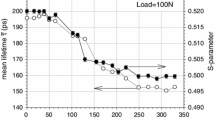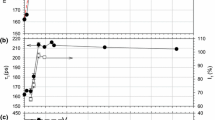Abstract
We present positron annihilation studies of the subsurface zones induced in the sliding contact of two metals under lubrication conditions. The surfaces of copper samples were exposed to the sliding of a small steel ball and the open volume defects induced under the surface were detected using both a positron beam experiment and a conventional positron experiment. From our studies we deduced that the total range of subsurface zones was almost independent of the lubrication conditions. For the highest load of the ball we observed that the subsurface zone created under lubrication condition extends deeper than for the case where the zone was induced in the dry sliding contact. We found that sliding with lubricant induces a layer on the surface whose properties, as detected by positrons, were different than those of other samples. It seems that this layer could contain open volume defects that are larger than those in deeper layers. Our studies have shown that the positron beam technique is a suitable tool for defect characterization in tribotested samples.
Similar content being viewed by others
References
J. Dryzek, E. Dryzek, T. Stegemann and B. Cleff, Tribol. Lett. 3 (1997) 269.
J. Dryzek, E. Dryzek and B. Cleff, Appl. Surf. Sci. 116 (1997) 236.
J. Dryzek and A. Polak, Tribol. Lett. 7 (1999) 57.
F. Börner, S. Eichler, A. Polity and R. Krause-Rehberg, J. Appl. Phys. 84 (1998) 2255.
J. Dryzek, E. Dryzek and A. Polak, in: Proc. 2nd COST 516 Tribology Symposium, eds. J. Meneve and K. Vercammen, Flemish Institute for Technological Research Boeretang 200, p. 31.
H.D. Gu, T.M. Wang, W.J. Wang, K.M. Leung and C.Y. Chung, Appl. Phys. A 68 (1999) 325.
J. ¡ Cížek, I. Procházka, P. Vostrý , F. Chmelík and R.K. Islamgaliev, Acta Phys. Pol. 95 (1999) 487.
N. Djourelov and M. Misheva, J. Phys. 8 (1996) 2081.
P.J. Schultz and K.G. Lynn, Rev. Mod. Phys. 60 (1980) 701.
G.C. Aers, K.O. Jensen and A.B. Walker, in: Slow Positron Beam Techniques for Solids and Surfaces, AIP Conf. Proc., Vol. 303, eds. E. Ottewitte and A.H. Weiss (AIP Press, New York, 1994) p. 13.
D.T. Britton, P.A. Huttunen, J. Mäkinen, J. Soininen and A. Vehanen, Phys. Rev. Lett. 62 (1989) 2413.
H.-E. Schaefer, Phys. Stat. Sol. A 102 (1987) 47.
A. van Veen, H. Schut, J. de Vries, R.A. Hakvoort and M.R. IJpma, in: Positron Beam For Solids and Surfaces, AIP Conf. Proc., Vol. 218, eds. P.J. Schultz, G.R. Massoumi and P.J. Simpson (London, Ontario, 1990) p. 171.
D.A. Rigney, Wear 245 (2000) 1.
T. Wider, S. Hansen, U. Holzwarth and K. Maier, Phys. Rev. B 57 (1998) 5127.
Author information
Authors and Affiliations
Rights and permissions
About this article
Cite this article
Dryzek, J., Dryzek, E., Börner, F. et al. Subsurface Zones Created Under Lubrication Conditions Studied by Positron Annihilation. Tribology Letters 11, 29–36 (2001). https://doi.org/10.1023/A:1016647914125
Issue Date:
DOI: https://doi.org/10.1023/A:1016647914125




